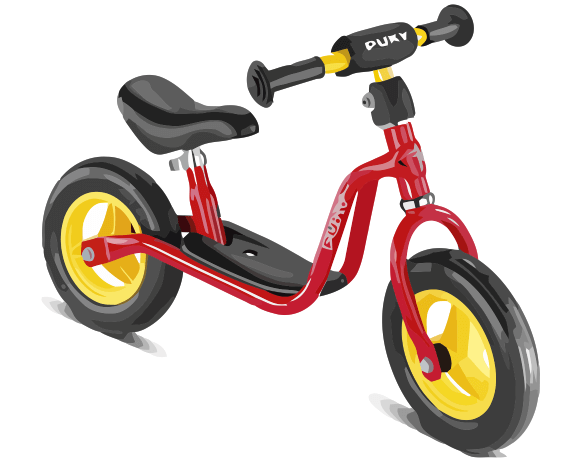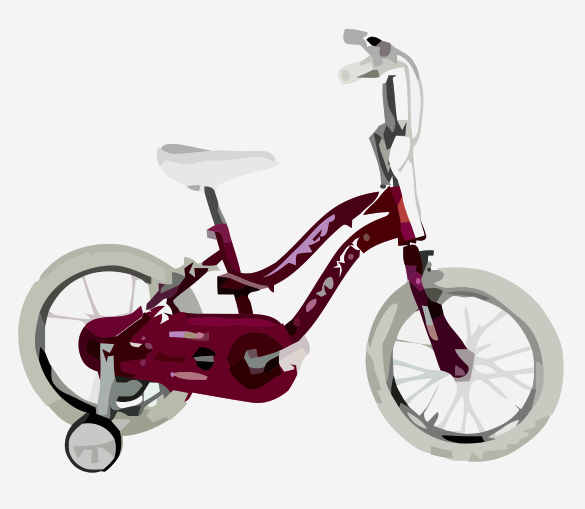Teach Your Child How To Ride a Bike
One of the most memorable experience parents can have with their children is to teach them how to ride a bike. However, if you don't approach it properly it can also be a stressful experience, for both the parent and the child. Below are some pointers to help you with this experience. But before you get started, wait for your child to actually want to learn. If you rush them, they may not enjoy it.
Choosing a Bike
Don't underestimate the importance of the right pick for kids. And don't just focus on cosmetics like getting the a good color.
- Brakes: Get a bike with both front and back brakes. It's important that they learn the concept of braking early and how to do it properly.
- Size: It is very tempting to get a larger bike thinking that it should last them for many years. This wont' work. First of all, it will be dangerous while they are still small. Second of all, they will want a new one at least every 2 years anyway. So, get one that fits, and when the time comes sell it and buy a new one.
- Cost: Don't go for the cheapest bike possible. You get what you pay for. If it's too cheap they won't like it and they won't ride it, especially if their friends have better bikes.
- Pedals: If money is no object to you, buy a bike that doesn't have any pedals or a drivetrain (chain, crankarms, etc.). Why? Read further down for more info. Then, after learning to balance, buy another bike with pedals and a drivetrain.
Safety
Make sure you purchase, and your child wears, a properly fitting helmet designed for bicycle riding. Get a little bell as it's a good habit to get into. Make sure they are wearing proper closed shoes, not sandals. I also suggest gloves in case they fall so they won't scrape their hands. Long jeans are also a good idea, in case they fall, to protect the knees.
Before going any further show them how the brakes work. Have them practice on the spot. Make sure they are pulling both brakes, the front and back, at the same time. Then, give them a little push while holding onto them and have them brake. Do this a few times until they get the hang of it.
Balancing and Pedaling
There are two basic components to learning how to ride and both must be accomplished in order to ride properly. Balancing is the obvious one, but many parents don't realize that pedaling is not something that comes naturally, and must also be learned. If you teach these two aspects separately, most children will earn faster.
 Child's Bike With No Pedals
Child's Bike With No PedalsBalancing: The act of keeping the bike balanced in an upright position.
- If there are trainer wheels, remove them.
- If there are pedals remove them (left pedal is a reverse thread). If you don't remove them your child will keep hitting his shins on the pedals and won't like it.
- Adjust the seat so he can place both feet flat on the ground while remaining on the saddle.
- Find a place and let him ride by pushing the bike with their legs. Let him go and have fun. A slight, short decline may help.
- Once they get the hang of it, he will either push with both of his legs at the same time, or one leg and then the other. If he is pushing with both together, encourage him to learn to push one at a time, as this is closer to mimicking pedaling.
- Don't rush him before you move on, have him practice at this stage for quite a bit. Maybe create obstacle courses for him to go through, have him learn to ride down and up hills (nothing too steep of course).
 Child's Bike With Training Wheels
Child's Bike With Training WheelsPedaling:
- Don't rush your child to this stage. But once you think he has a good handle on balancing then put on the pedals.
- Do NOT put on the trainer wheels.
- Show him how the pedals work, don't assume he knows.
- To start, the pedal of the leading foot should always be in the forward position.
- If you can find a slight short decline it might make it easier for him.
- He might need a bit of a push to get the pedaling started.
- You might need to run with him for a bit.
- Once in a while remind him to use the brakes.
If for some reason you decide to teach your child how to the pedal first, then purchase a bike with easy to remove trainers.
Additional Pointers
- Don't give him too much verbal direction. Let him explore and learn on his own, it will mean more to him.
- Encourage him to visually focus up ahead where he wants to go. If he focuses on the light post just up ahead, he will ride right into it.
- Don't panic when he falls, and he will. It's all part of learning to ride.
- Once he is comfortable and good enough, ride with him at the local park.
- Always wear your helmet. If your child see you without it, he will resist wearing his.
- Of course, teach him proper etiquette and respect for pedestrians and other children riding.
If You're An Adult Learning to Ride
The concept is exactly the same. Try it first with no pedals going down a small hill. Extend the distance, learn to push with your feet and learn to balance. Then, put on the pedals. As an adult you have the advantage of understanding the physics a bit better, but you have the disadvantage of fear. Do this in a safe, traffic free area, and wear your helmet.
Once you've learned how to ride you should raise the saddle. See our article about proper bike fitting. The proper way to stop is not with both feet on the ground. Ideally, when stopping, you should lean your body slightly forward so your rear-end is off, and just in front of the saddle, one foot stays on the pedal, and the other foot steps on the ground. Practice this a bit before going on the road with traffic.




Leave a Reply